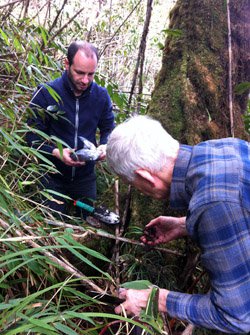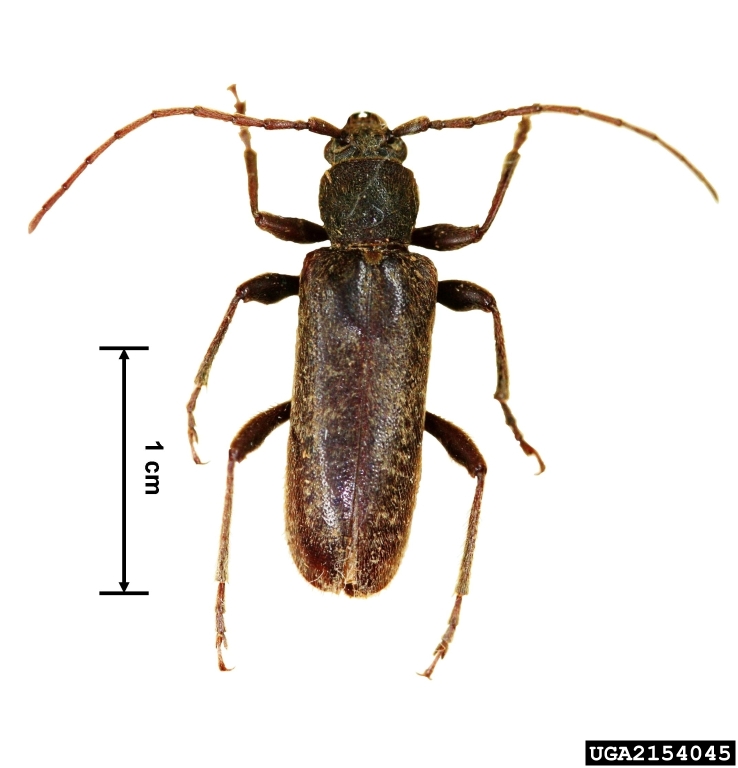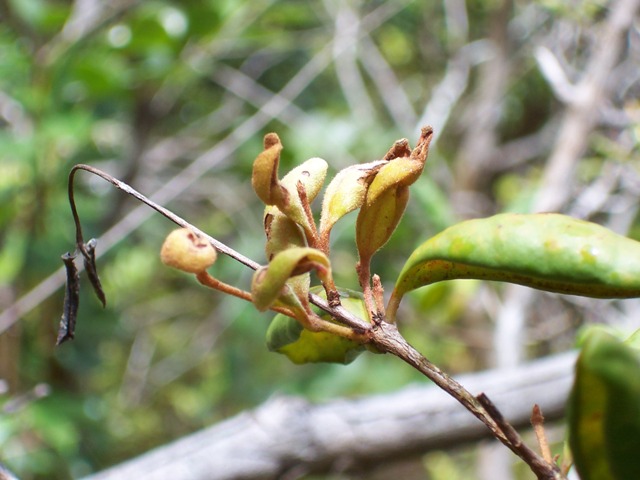
I have written often about failings of the international phytosanitary systems – starting with my report Fading Forests II in 2004, and continuing in many blogs. As the International Year of Plant Health comes to an end, I do so again. I begin with a key recommendation.
Australia’s experience dealing with myrtle rust (Austropuccina psidii) demonstrates the need to integrate agencies responsible for conservation of natural ecosystems into the determination and implementation of phytosanitary policy.
These environmental agencies should be active participants in setting up surveillance and diagnostics protocols and on-the-ground surveillance, and should be directly involved in emergency response. Federal agricultural agencies have technical expertise in biosecurity but lack expertise in key elements of environmental management. In the Australian context, this recommendation is made by several studies cited by Carnegie and Pegg (2018) – full citation at the end of this blog. I strongly endorse the recommendation for the United States. In the U.S., the appropriate agencies would include USDA’s Forest Service and the Department of Interior’s Fish and Wildlife Service.
While the USDA Forest Service is (apparently) more involved in US phytosanitary efforts than its Australian counterpart, its voice in setting USDA phytosanitary policy is limited to the most narrow details, e.g., treatment protocols for wood packaging.
Carnegie and Pegg note a second common problem: the ongoing decline in forest entomology and pathology capacity in government agencies. This decline has long been decried by U.S. natural resource experts as depriving agencies of needed expertise – but we have not yet managed to raise agency budgets so as to reverse it.
The forests of Australia, New Zealand, nearby islands, and South Africa formed during the period of the supercontinent Gondwana – 300 million years ago. While the threat to these unique forests from non-native pests is severe, so far it arises from a limited number of organisms. These are Phytophthora cinnamomi, Austropuccinia psidii, polyphagous shot hole borer and Fusarium fungus (in South Africa), and – in the future, laurel wilt disease. All these organisms threaten multiple hosts. In contrast, the threat to America’s forests comes from more than 100 highly damaging non-native insects, pathogens, and nematodes already here. Some threaten multiple hosts. Plus there is the constant risk of new introductions. Surely our federal conservation agencies have important resources to defend and expertise to contribute to the effort.
Flaws in the System
The international phytosanitary rules adopted by both the World Trade Organization’s Agreement on the Application of Sanitary and Phytosanitary Measures [WTO SPS Agreement] and the International Plant Protection Convention [IPPC] are fundamentally flawed. That is, they require regulatory officials to be unrealistically certain about an organism’s “pest” potential before regulating it. Yet uncertainty is likely to be at its highest at two critical times: before invasion or at its earliest stage. These times are precisely when phytosanitary actions are likely to be most effective.
The effect of this demand for certainty is exacerbated by decision-makers’ caution when confronted with the potential that their action might harm an economic interest. The vast majority won’t impose a regulation until they are sure that the organism under consideration poses a major threat to plant health.
Yet at the same time, most phytosanitary officials rarely carry out the scientific studies that might answer such questions about the risk.
For example, USDA APHIS has created its own Catch 22. It has not funded laboratory tests to get preliminary information on how vulnerable North American tree genera are to the 38 new Phytophthora species detected in Southeast Asia [see earlier blog]. European scientists are doing this testing; it is unclear whether their work is supported by European governments. American scientists could build on the Europeans’ work since our continents share many plant genera – but since vulnerability might vary at the species level, we still must assess North American species separately. At the same time as APHIS is not sponsoring such tests, it refuses to propose acting under its NAPPRA authority link to temporarily prohibit imports of Asian hosts of the Phytophthoras because it lacks information demonstrating the risk they pose to North American plants!
Sometimes, other agencies step in to fill the gap. Thus, the USDA Forest Service funded research to demonstrate that strains of the ‘ōhi‘a rust pathogen not yet introduced to the U.S. posed a risk to native plants in Hawai`i. (See the linked description and additional information later in this blog.) The Forest Service has also funded “sentinel gardens” – plantings inside the U.S. and abroad that are closely monitored to detect new pests.
Three pathogens illustrate the problems clearly:
1) brown alga in the Phytophthora genus;
2) myrtle (or ohia or eucalyptus) rust Austropuccinia psidii; and
3) the ophiostomatoid laurel wilt fungus Raffaelea lauricola.
These organisms present a variety of challenges to various countries. Individually and together, these pathogens threaten to transforms forest floras around the world.
Spread: the first two are spread internationally by movement of plants for planting but also spread locally by rain or wind. The third, laurel wilt fungus, arrived in the U.S. when its insect vector, the redbay ambrosia beetle Xyleborus glabratus, hitched a ride in solid wood packaging material.
How countries prepared for pathogen invasion – not always successfully
Numerous plant pathogens in the Phytophthora genus have long had the attention of phytosanitary officials. However, the species that causes sudden oak death (P. ramorum) was unknown when it was introduced to North America and Europe in the late 1980s or early 1990s. The established phytosanitary measures on two continents failed to detect and prevent its introduction.
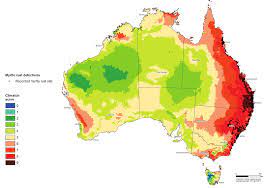
The myrtle rust pathogen was already recognized by phytosanitary officials in Australia, New Zealand, and New Caledonia as a severe potential threat, especially to Eucalyptus in both natural forests and plantations. Its appearance in Hawai`i in 2005 raised the level of concern. However, that awareness neither prevented its entry to Australia (probably, although not certainly, on imported plants or foliage) nor prompted its detection early enough for eradication. New Zealand and New Caledonia became infested by wind transport of the pathogen from Australia. [For a thorough discussion of the Australia’s extensive preparations for possible introduction of this pathogen, see Carnegie and Pegg 2018, full citation at the end of this blog.]
The laurel wilt fungus was unknown before it was detected in Georgia, U.S.A. Phytosanitary officials were certainly aware of the pest risk associated with wood packaging material (see Fading Forests II, chapter 3) but at the time the invasion was detected – 2003 – U.S. regulations required that the wood be debarked only, not treated to kill pests.
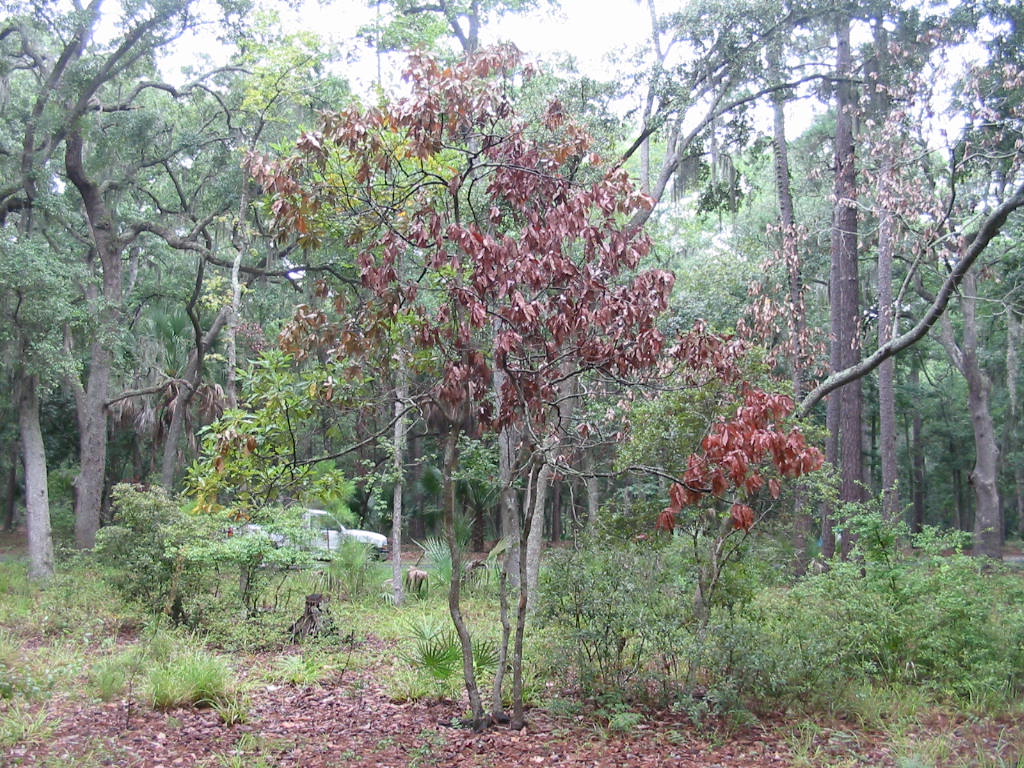
Pathogens are more difficult to detect and manage than insects. They also get less attention. I can think of three possible reasons: 1) Usually we can’t see a pathogen – we literally can’t put a face on the “enemy”. 2) Disease intensity can vary depending on ecological factors, so it is more difficult to understand than an insect feeding on a plant. 3) In recent decades, many invading insects have been linked to a singlepathway of introduction — wood packaging — while pathogens enter through association with a myriad of imports, especially a variety of imported plants. A single pathway is a concept that is easier to understand and address. Because pathogens get little attention, it is more difficult to obtain data quantifying their risks.
The rapid spread and high mortality of laurel wilt in one host – redbay trees (Persea borbonia) – and threat to a second—sassafras (Sassafras albidum) – have alerted scientists to this threat. The pathogen apparently threatens trees and shrubs in the Lauraceae family that are native to regions other than Southeast Asia. These areas include the tropical Americas, Australia, Madagascar, and islands in the eastern Atlantic (Azores, Canary Islands, and Madeira). I understand that Australian phytosanitary officials are aware of this risk, but I don’t know about officials in the other regions. For example, laurel wilt is not listed among the pathogens thought to pose the greatest risk in Europe, i.e., the A1 list of the European and Mediterranean Plant Protection Organization (EPPO)
Why do some organisms suddenly disperse widely? Who is figuring out why?
The myrtle rust pathogen Austropuccinia psidii experienced a burst of introductions after 2000: it was detected in Hawai`i in 2005, Japan in 2009, Australia in 2010, China in 2011, New Caledonia and South Africa in 2013, Indonesia and Singapore in 2016, and New Zealand in 2017. It is believed to have been carried to Hawai`i on cut vegetation for the floral trade; to New Caledonia and New Zealand by wind from Australia across the Tasman Sea. The introduction pathway to Australia has never been determined, although it first was detected in a nursery. I don’t have information on how it was introduced to Japan or China. Has anyone tried to figure out what triggered this expansion? Was it some fad in horticulture or floriculture? Would it not be useful to learn what happened so we can try to prevent a repetition?
Similar sudden dispersals occurred during roughly the same period for Phytophthora ramorum and the erythrina gall wasp (Quadrastichus erythrinae). The latter spread across the Indian and Pacific oceans within a dozen years of its discovery. Again, was there some fad that prompted international trade in host material? Or did the insect suddenly start utilizing transport facilities such as aircraft interiors or holds? Has anyone tried to figure this out? I doubt anyone is even searching for and recording the presence of the gall wasp now that it is so widespread.
Is the fungal genus Ceratocystis experiencing a similar dispersal burst now? Australian authorities (Carnegie and Pegg 2018) have noted Ceratocystis wilts threatening Acacia and Eucalyptus, as well as Metrosideros.
Efforts often wane at the management and restoration stages.
In the cases of all three pathogens, governments have reduced their efforts once they determined that they could not eradicate the pest.
In North America, USDA APHIS regulates movement of nursery stock with the goal of preventing spread of P. ramorum to the East. The agency has reduced the stringency of its regulations several times over the 18 years it has been regulated. These changes have been made at the urging of the nursery industry in California and Oregon, which are where the pathogen is present. Two years ago, a major regulatory failure resulted in infected plants being shipped to more than 100 retailers in more than a dozen states. This had huge costs to dozens, if not hundreds, of nurseries and state regulatory agencies. Yet APHIS has neither published a straightforward and complete analysis of what went wrong, nor promised to correct any weaknesses revealed by such an analysis. Another apparent regulatory failure is the appearance of the EU1 strain of P. ramorum in the country; this seems to indicate that introductions to North America have occurred more recently than the initial introduction in the late 1980s or early 1990s.
In Hawai`i, concern about the potential impact of myrtle rust on the Islands’ dominant native tree species, ‘ōhi‘a (Metrosideros polymorpha), spurred action. Although myrtle rust spread to all the islands within months, the state imposed an emergency rule prohibiting importation to the state of Myrtaceae plants or cut foliage in 2008. This action was relatively rapid, although it was three years after detection of the pathogen. The rule aimed to prevent introduction of possibly more virulent strains. However, it expired in 2009 (emergency rules are effective for only one year).
Concerned about the possible impacts of various strains, the USDA Forest Service sponsored studies in Brazil. Based on their findings, Hawai`i adopted a new permanent rule in 2020. It prohibited importation of plants or foliage of all Myrtaceae species.
Also, APHIS proposed in November 2019 a federal regulation to support the state’s action through its NAPPRA authority. However, it took seven years to resolve regulators’ concerns about the possible presence and virulence of various strains. During this time importation of high-risk materials was not prohibited. As of this writing, it has been 18 months since APHIS proposed the NAPPRA listing, so federal rules still allow imports of high-risk material.
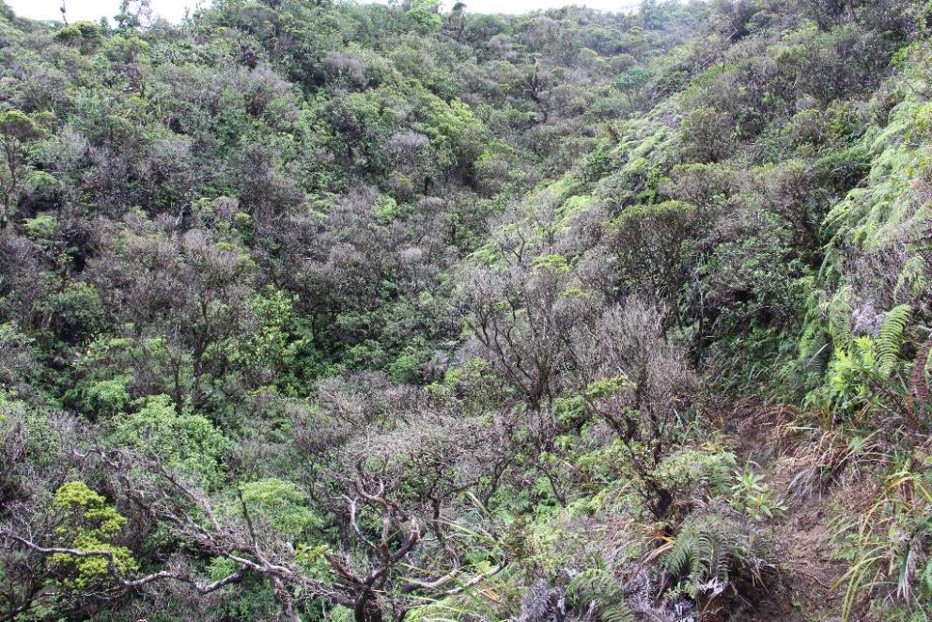
Meanwhile, the focus of on-the-ground conservation and restoration efforts in Hawai`i has shifted to different pathogens, those causing rapid ‘ōhi‘a death dontmovefirwood.org
In Australia and New Zealand, federal officials determined within months of detection that myrtle rust was too widespread to be eradicated. They now focus on trying to prevent introduction of additional strains. Within the country, Australia prohibits movement of Myrtaceae (hosts of myrtle rust) to the two states so far free of the pathogen (South and West Australia). However, some scientists believe enforcement of these regulations is too lax. In New Zealand, nurseries are reported to be very careful to produce plants free of the pathogen. Is this sufficient?
The Australian government also funds seed collection and other ex situ conservation efforts. But little funding has been available even for impact studies. In Australia, funding from both state (New South Wales) and federal authorities became available only after designation of three plant species as endangered. The federal government also has not designated myrtle rust as a “key threatening process,” which would have opened access to significant funds and possibly prompted more vigorous regulatory efforts. The rust is included as part of the process “novel biota threat to biodiversity”, but scientists and activists consider this to be insufficient. A conservation strategy https://www.anpc.asn.au/myrtle-rust/ was developed by a coalition of non-governmental organizations and state experts. While never adopted by the federal government, this plan became the basis for a state strategy adopted by New South Wales in 2018 – eight years after the pathogen was first detected. For a thorough discussion of weaknesses in the Australian phytosanitary system’s response to the myrtle rust introduction, see Carnegie and Pegg 2018, full citation at the end of this blog.
In June 2021, the Australian Center for Invasive Species Solutions (CISS) and the office of the Chief Environmental Biosecurity Officer (CEBO) released a revised National Environment and Community Biosecurity RD&E Strategy. The sponsors sought feedback on the strategy from biosecurity and biodiversity researchers, investors, practitioners, the community, government and industry. Comments are due by 16 July 2021. The strategy is posted at https://haveyoursay.awe.gov.au/necbrdes
In New Zealand, the science plan for myrtle rust was described as advisory. The little funding available precludes resistance breeding and seed collection. There is not even a national program to track the rust’s spread.
Difficulties in Assessing Impact
Myrtle rust affects largely new growth of host plants, including flowers and seedlings and root sprouts. Thus, in many – but not all – host species the threat is primarily to reproduction rather than immediate mortality of mature plants. This delay in impacts complicates assessments of the threat posed by the rust.
NGO Action in Australia
After several years’ effort to build a broader coalition to support implementation of the NGO Action Plan, the Plant Biosecurity Science Foundation sponsored an international workshop in March 2021. The goal was to increase understanding of the rust and its impact and who is doing what. Time was devoted to discussions on how coordinate efforts to both raise awareness and spur government action. State and federal officials played prominent roles in both preparation of the Action Plan and the workshop – and did not shy away from criticizing Australia’s handling of the threat. The descriptions of myrtle rust’s impacts presented at the conference were much more dire than those of a few years ago. Information on impacts has accumulated slowly due to the few scientists doing the work. See https://www.apbsf.org.au/myrtle-rust/
Greater alarm about this pathogen is warranted.
Australia – Evidence of Disaster
According to speakers at the workshop, myrtle rust is causing an expanding disaster in Australia, where the flora is dominated by Myrtaceae. As of spring 2021, myrtle rust is widespread and well established in several native ecosystems in the eastern mainland states of New South Wales and Queensland and part of the Northern Territory. The disease has been detected in Victoria and Tasmania but impact is limited to urban gardens. It has not yet been detected in South or Western Australia. At this time, 382 of Australia’s Myrtaceae species – in 57 genera – are known to host the rust. Three species have been officially listed as critically endangered. Rhodamnia rubescens and Rhodomyrtus psidioides are formerly widespread understory trees in rainforests. Lenwebbia sp. is narrowly endemic, growing in stunted cloud forests on clifftops in a single mountain range. However, experts predict extinction of 16 rainforest species within a generation. (For comparison, only 12 plant species in Australia have become extinct since arrival of the first Europeans 200 years ago.) Several speakers at the conference stressed the speed at which rust is putting plant taxa in peril. Wetlands dominated by Melaleuca are apparently under immediate threat.
[For a thorough discussion of the rust’s impact on plant communities, see Carnegie and Pegg 2018, full citation at the end of this blog.]
New Zealand The vulnerability of each of the 27 – 30 native plant species remains unclear three years after the rust’s introduction.
New Caledonia The highly endemic flora of this small island group appears to be at great risk.
In Hawai`i, the rust has devastated one endangered plant species (Eugenia koolauensis) and damaged a non-endangered congener, E. reinwardtiana. The strain currently on the Islands does not threaten the dominant native tree species, ‘ōhi‘a (Metrosideros polymorpha).
Southern Africa
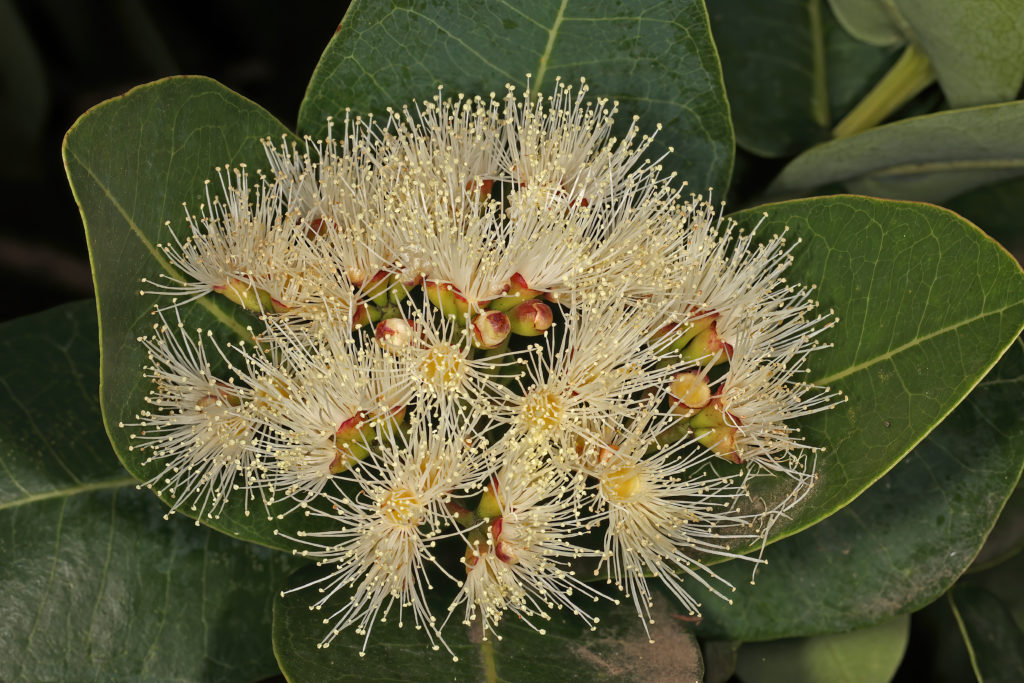
South Africa has 24 native plant species in the Myrtaceae. I have been unable to learn the vulnerability of these species to the rust. South Africa relies heavily on plantation of Eucalyptus, some species of which might be vulnerable to the rust. The variant of the rust detected in South Africa 2013 is unique.
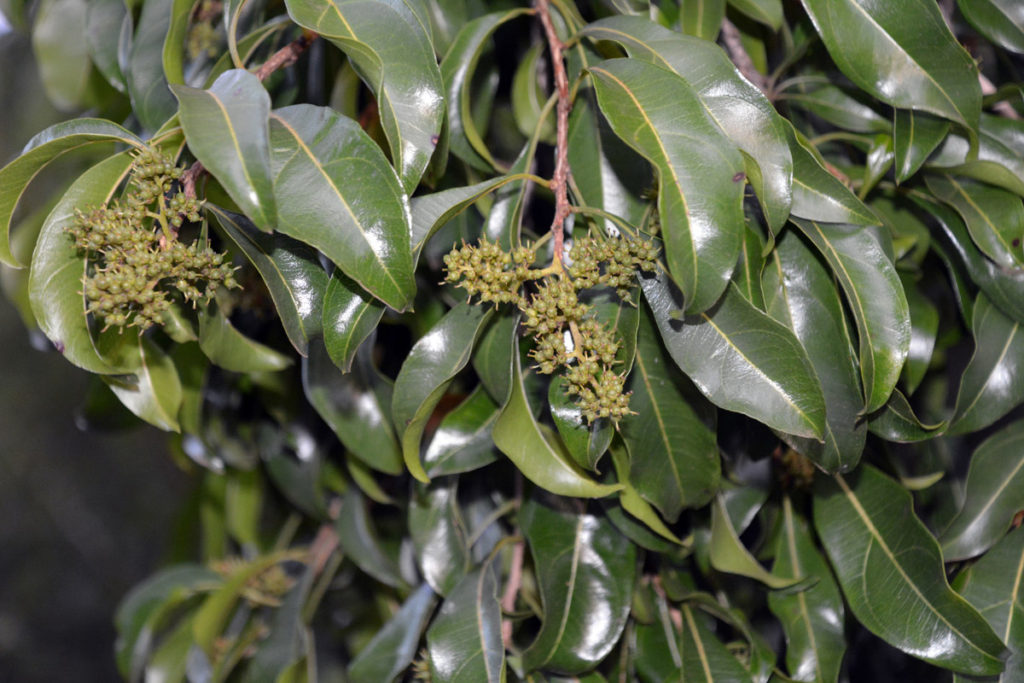
Posted by Faith Campbell
We welcome comments that supplement or correct factual information, suggest new approaches, or promote thoughtful consideration. We post comments that disagree with us — but not those we judge to be not civil or inflammatory.
For a detailed discussion of the policies and practices that have allowed these pests to enter and spread – and that do not promote effective restoration strategies – review the Fading Forests report at http://treeimprovement.utk.edu/FadingForests.htm
SOURCES
Angus J. Carnegie, A.J. and G.S. Pegg. 2018. Lessons from the Incursion of Myrtle Rust in Australia. Annual Review of Phytopathology · August 2018
Jung, T.; Horta Jung, M.; Webber, J.F.; Kageyama, K.; Hieno, A.; Masuya, H.; Uematsu, S.; Pérez-Sierra, A.; Harris, A.R.; Forster, J.; et al.. The Destructive Tree Pathogen Phytophthora ramorum Originates from the Laurosilva Forests of East Asia. J. Fungi 2021, 7, 226. https://doi.org/10.3390/ open access!
